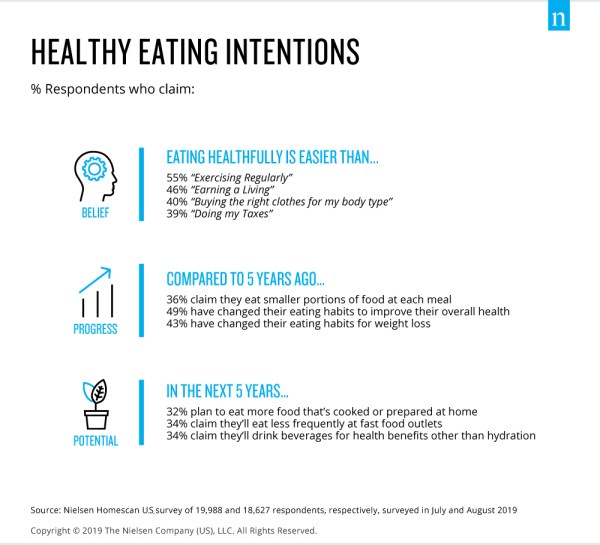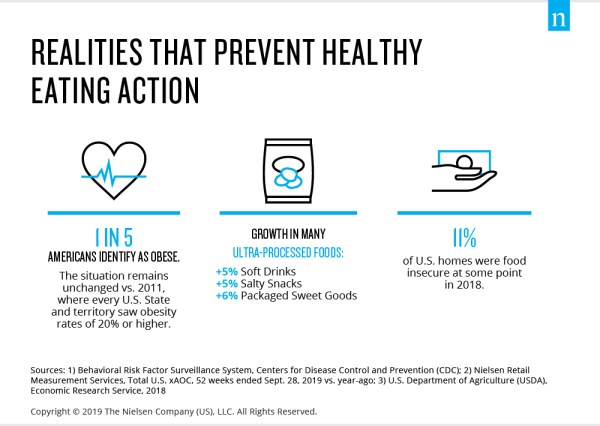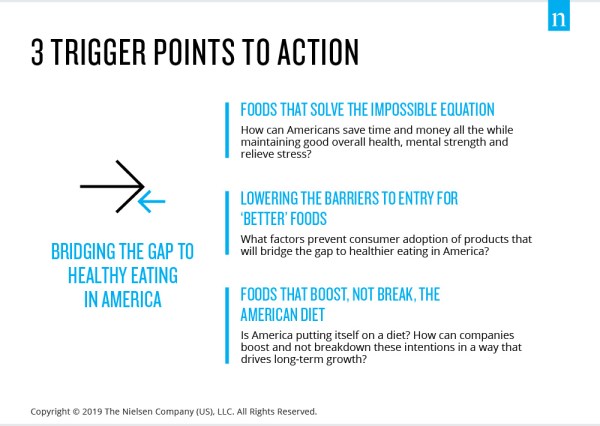Americans want to eat healthfully. And it’s this intention to eat better that should serve as a guide for food and beverage companies into 2020 and beyond.
We’re all human, and that means we don’t always do as we say. But there are reasons for that. Some are logical, others are emotional…but the gap is real. And the smartest companies are dialed into the nature of human behavior. They’re evolving and maneuvering to bridge the gap between what people want and what stands in the way of following through on those wants. If consumers have an intent to change, even at a subconscious or subliminal level, marketers need to do everything they can to transform that intention into action.
The brands that will capitalize on the future of American foods, are those that identify and solve for the conditions that cause our intentions and subsequent actions to stray. NielsenIQ research confirms, only one-third of Americans say their eating habits have remained the same over the last five years. Eating patterns are in flux, and the intentions for healthier eating are clear.

From
claiming to eat smaller portion sizes with each meal to planning to cut back on
fast food in the next five years, many Americans believe their path to better
eating is already a work-in-progress. But there’s a bias that lives in all of
us. Whether by choice or by necessity, what we want to eat and drink doesn’t always manifest in reality.

Eating healthfully might be easier said than done, but many Americans believe it’s easier than an array of other everyday activities. For example, 55% say it’s easier than exercising regularly, 46% say it’s easier than earning a living and 39% say it’s easier than doing their taxes. But the reality is that one in five Americans are considered obese—a figure that’s held steady since 2011. In another example, nearly half of Americans say they’ve changed their eating habits to improve their overall health, yet sales of many ultra-processed foods (e.g., soft drinks +5%; salty snacks +5%; packaged sweet goods +6%) continue to post strong year-over-year sales growth. And, more often than you might think, factors as simple as affordability or availability can hinder the intention to eat healthier. According to the U.S. Department of Agriculture (USDA), one in nine U.S. households were food insecure (or, uncertain of having or unable to acquire enough food) at some point in 2018.
Bridging
the gap between intentions and harsh realities is where growth opportunity
lies. Not sure where to start? Below are three trigger points for action that,
when aligned to the right products, can serve as leverage points to closing
this gap.

It’s time for consumers to convert best intentions into best actions. And marketers play a key role in activating the closure of this break between intention-to-action. For a deeper exploration on how eating trends could shift for Americans in the years to come, take a look at NielsenIQ’s How America Will Eat online report.



